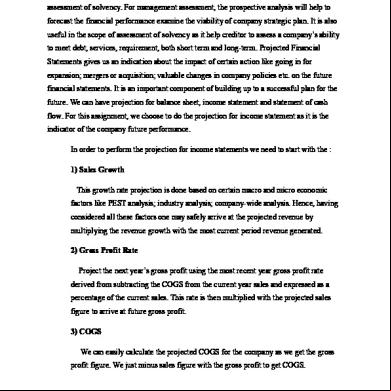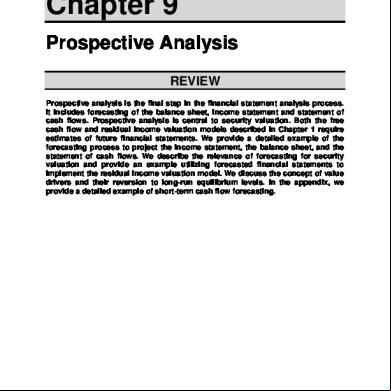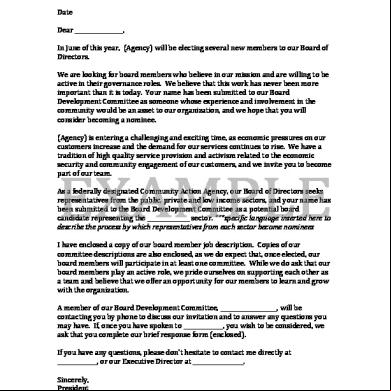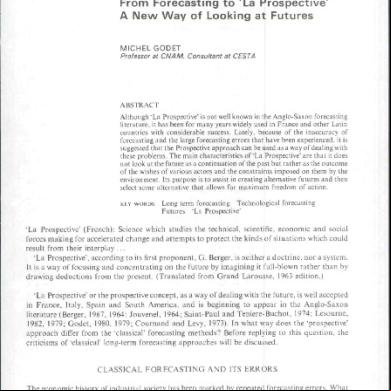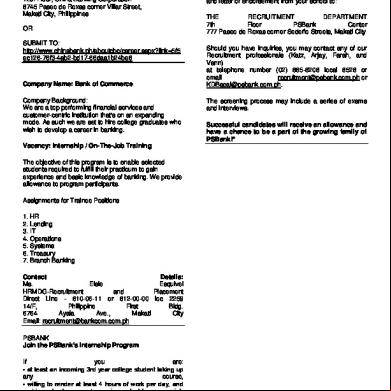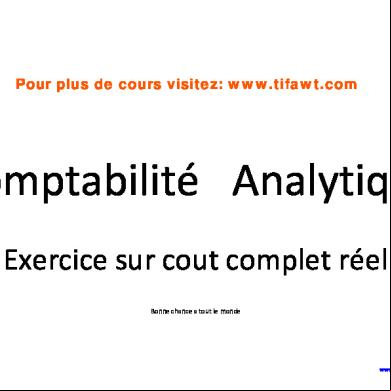Prospective Analysis c2jr
This document was ed by and they confirmed that they have the permission to share it. If you are author or own the copyright of this book, please report to us by using this report form. Report 3b7i
Overview 3e4r5l
& View Prospective Analysis as PDF for free.
More details w3441
- Words: 554
- Pages: 3
PROSPECTIVE ANALYSIS Prospective analysis is important for security valuation, management assessment and assessment of solvency. For management assessment, the prospective analysis will help to forecast the financial performance examine the viability of company strategic plan. It is also useful in the scope of assessment of solvency as it help creditor to assess a company’s ability to meet debt, services, requirement, both short term and long-term. Projected Financial Statements gives us an indication about the impact of certain action like going in for expansion; mergers or acquisition; valuable changes in company policies etc. on the future financial statements. It is an important component of building up to a successful plan for the future. We can have projection for balance sheet, income statement and statement of cash flow. For this assignment, we choose to do the projection for income statement as it is the indicator of the company future performance. In order to perform the projection for income statements we need to start with the : 1) Sales Growth This growth rate projection is done based on certain macro and micro economic factors like PEST analysis; industry analysis; company-wide analysis. Hence, having considered all these factors one may safely arrive at the projected revenue by multiplying the revenue growth with the most current period revenue generated. 2) Gross Profit Rate Project the next year’s gross profit using the most recent year gross profit rate derived from subtracting the COGS from the current year sales and expressed as a percentage of the current sales. This rate is then multiplied with the projected sales figure to arrive at future gross profit. 3) COGS We can easily calculate the projected COGS for the company as we get the gross profit figure. We just minus sales figure with the gross profit to get COGS.
4) Operating Expenses This could also be easily expresses as a percentage of current sales. Once, we get the operating expenses by sales rate, and then we can straight away multiply this rate with the projected sales rate in order to get the projected operating expenses. 5) Depreciation Expenses This expense can very well be projected by finding out the historical depreciation rate as a percentage of the prior period Gross PPE. That percentage is further multiplied with the current year sales figure in order to arrive at the projected depreciation expense in the next year. 6) Interest Expense Interest expense is derived by diving the current year’s interest expense by the previous year interest-bearing debt outstanding. Having got this rate, it is multiplied with the current year’s rate in order to arrive at the projected Interest Expense for the current year. 7) Income Tax Expense This is calculated by multiplying the projected income before tax with the tax-rate implied from the current year’s tax given as a percentage of current year’s income before tax.
Here is the income statement of both companies (Nestle & HupSeng) that we had chosen and the calculation of the item (listed above): Income Statement of NESTLE For The Year 2013 & 2014
Sales Cost of Goods Sold [COGS] Gross Profit Selling, General, and Expense
NESTLE 2013
NESTLE 2014
(RM)
(RM)
551,075,000
551,375,000
-
-
551,075,000
551,375,000
1,760,000
2,717,000
-
-
Depreciation and Amortization Expense Interest Expense Income before Tax Income Tax Expense Income (loss) from extraordinary item Net income
4) Operating Expenses This could also be easily expresses as a percentage of current sales. Once, we get the operating expenses by sales rate, and then we can straight away multiply this rate with the projected sales rate in order to get the projected operating expenses. 5) Depreciation Expenses This expense can very well be projected by finding out the historical depreciation rate as a percentage of the prior period Gross PPE. That percentage is further multiplied with the current year sales figure in order to arrive at the projected depreciation expense in the next year. 6) Interest Expense Interest expense is derived by diving the current year’s interest expense by the previous year interest-bearing debt outstanding. Having got this rate, it is multiplied with the current year’s rate in order to arrive at the projected Interest Expense for the current year. 7) Income Tax Expense This is calculated by multiplying the projected income before tax with the tax-rate implied from the current year’s tax given as a percentage of current year’s income before tax.
Here is the income statement of both companies (Nestle & HupSeng) that we had chosen and the calculation of the item (listed above): Income Statement of NESTLE For The Year 2013 & 2014
Sales Cost of Goods Sold [COGS] Gross Profit Selling, General, and Expense
NESTLE 2013
NESTLE 2014
(RM)
(RM)
551,075,000
551,375,000
-
-
551,075,000
551,375,000
1,760,000
2,717,000
-
-
Depreciation and Amortization Expense Interest Expense Income before Tax Income Tax Expense Income (loss) from extraordinary item Net income
